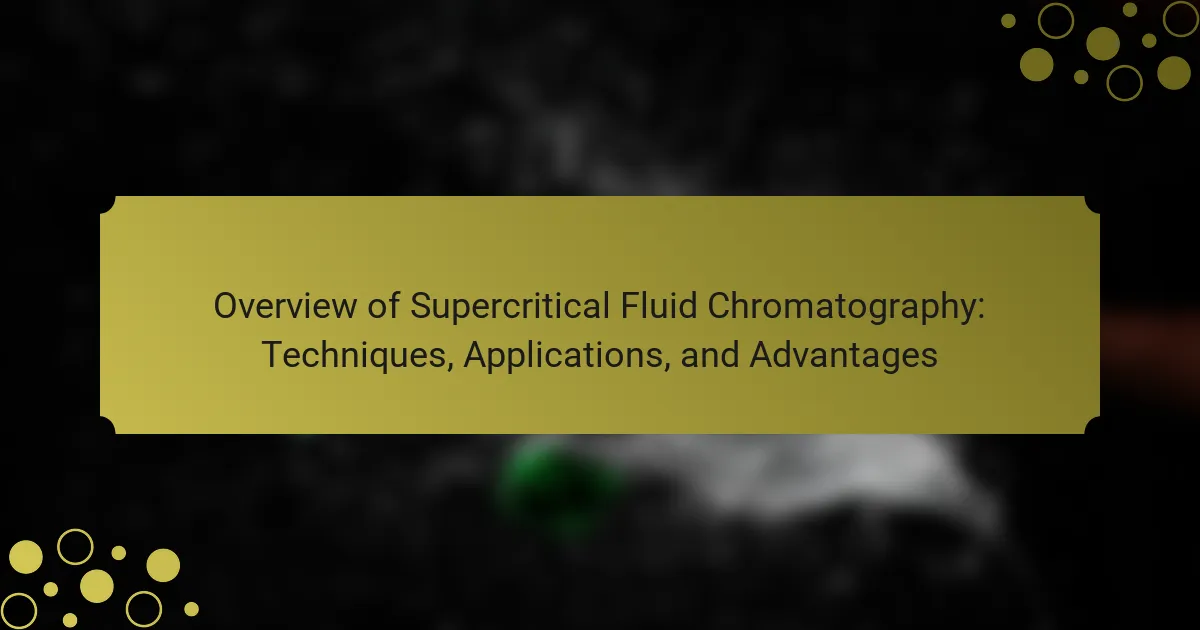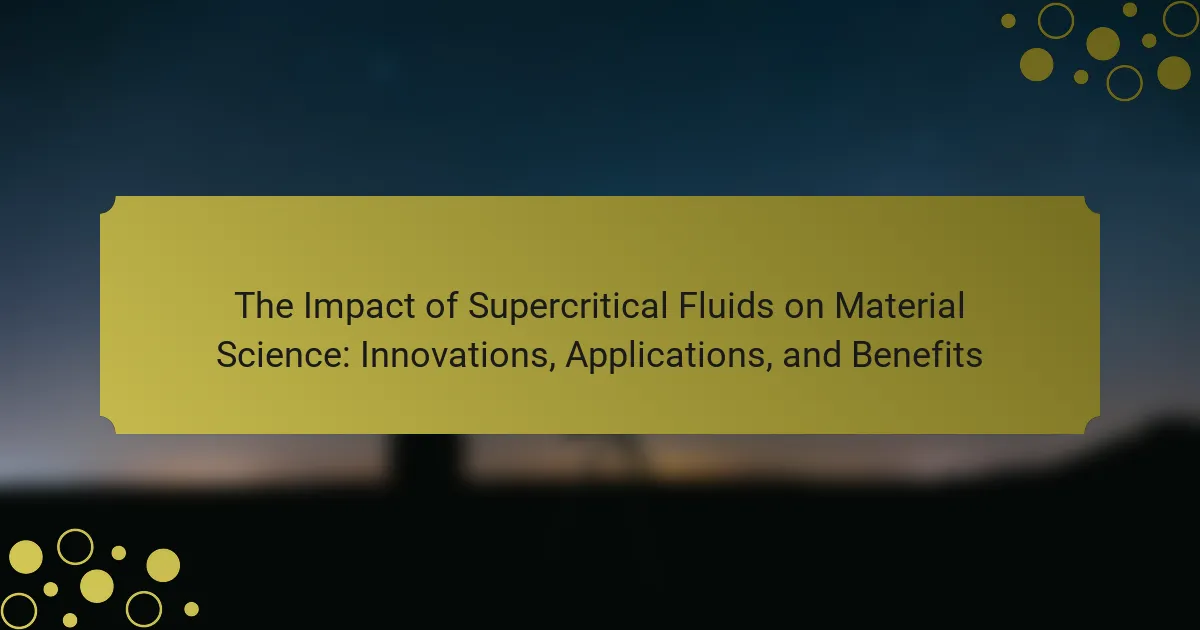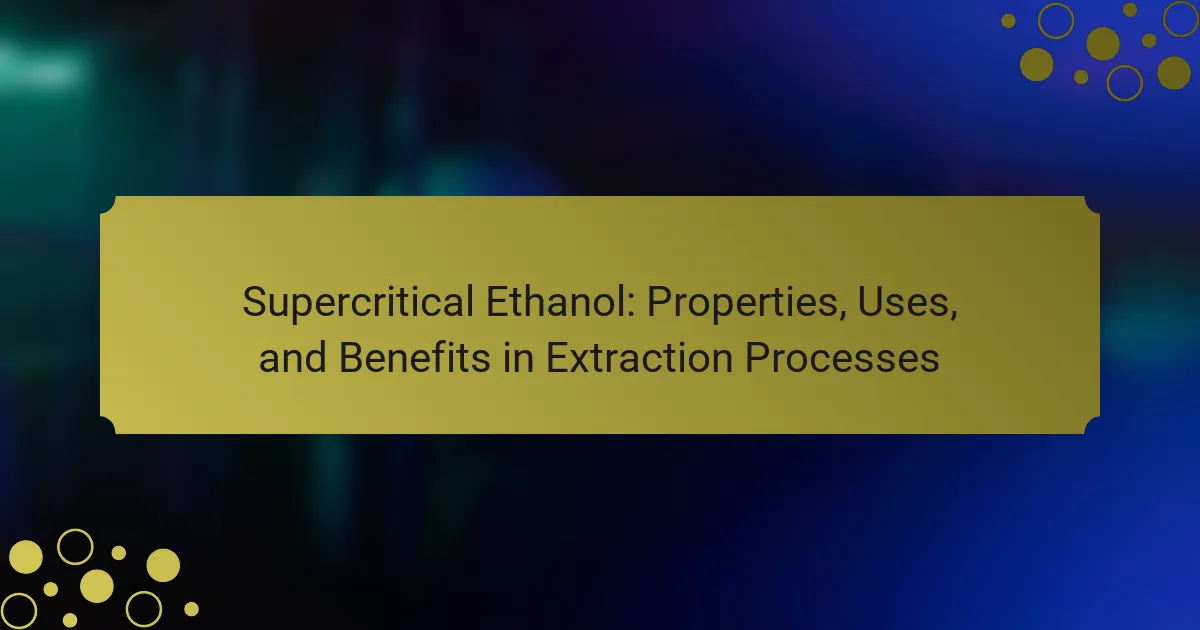Supercritical Fluid Technology utilizes supercritical fluids—substances that exist above their critical temperature and pressure—across various applications, including extraction processes in industries such as pharmaceuticals, food processing, and environmental remediation. Supercritical fluids, such as supercritical carbon dioxide, possess unique properties that enable efficient and selective extraction of compounds while minimizing the use of harmful solvents. This technology promotes environmental sustainability and enhances extraction efficiency, particularly for heat-sensitive materials. Future trends indicate ongoing advancements in extraction methods, increased pharmaceutical applications, and the integration of artificial intelligence to optimize processes, all contributing to a more efficient and eco-friendly approach to supercritical fluid technology.
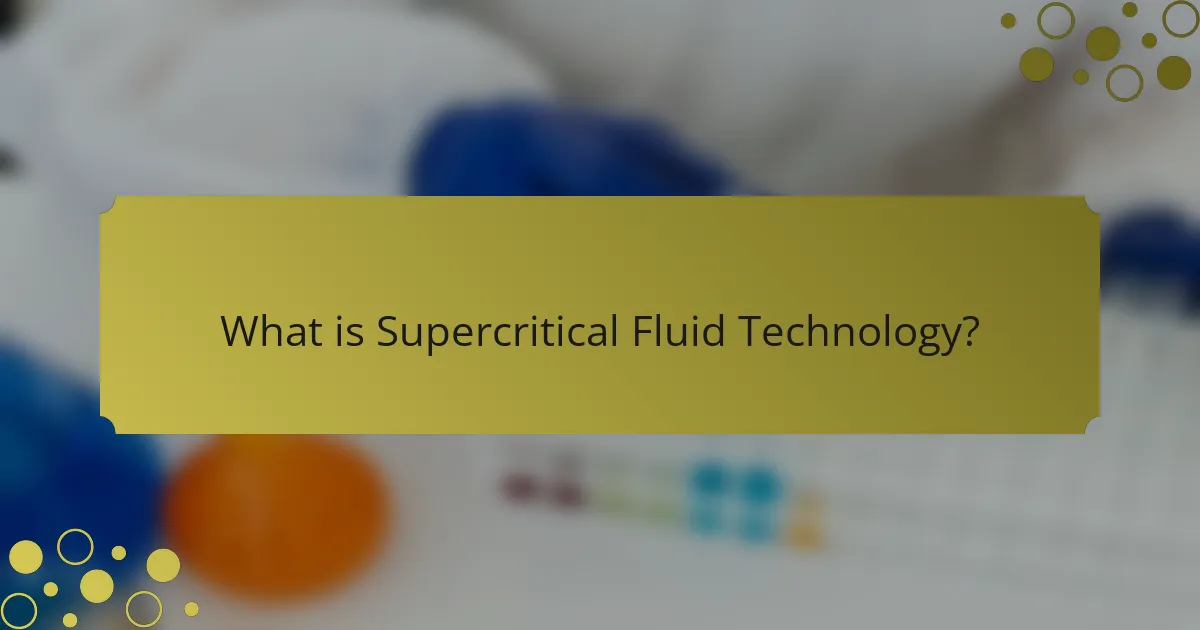
What is Supercritical Fluid Technology?
Supercritical Fluid Technology involves the use of supercritical fluids for various applications. A supercritical fluid is a substance at a temperature and pressure above its critical point. In this state, it exhibits properties of both liquids and gases. This unique behavior allows supercritical fluids to dissolve materials like a liquid while also having gas-like diffusion properties. Common examples include supercritical carbon dioxide, often used in extraction processes. The technology is applied in industries such as pharmaceuticals, food processing, and environmental remediation. Research indicates that supercritical fluid extraction can be more efficient and environmentally friendly compared to traditional methods.
How does supercritical fluid technology work?
Supercritical fluid technology works by utilizing fluids above their critical temperature and pressure. In this state, the fluid exhibits properties of both a liquid and a gas. The supercritical fluid can dissolve a wide range of substances, making it useful for extraction and purification processes. For example, carbon dioxide is commonly used as a supercritical fluid in the extraction of essential oils and caffeine. The process typically involves raising the pressure and temperature of the fluid until it reaches the supercritical state. This allows for efficient extraction without the use of harmful solvents. The technology is widely applied in industries such as pharmaceuticals, food processing, and environmental remediation.
What are the key properties of supercritical fluids?
Supercritical fluids exhibit unique properties that distinguish them from gases and liquids. They possess a density similar to that of liquids while maintaining the viscosity of gases. This allows supercritical fluids to dissolve substances effectively, making them excellent solvents. Additionally, supercritical fluids have high diffusivity, enabling them to penetrate materials easily. Their ability to modify density and solvation power with pressure and temperature adjustments provides versatility in various applications. Supercritical fluids also have low surface tension, which enhances their ability to interact with solid materials. These properties make supercritical fluids valuable in extraction processes, such as in the food and pharmaceutical industries.
What conditions are necessary to achieve a supercritical state?
To achieve a supercritical state, specific conditions of temperature and pressure must be met. The temperature must exceed the substance’s critical temperature. Additionally, the pressure must exceed the substance’s critical pressure. For example, carbon dioxide has a critical temperature of 31.1°C and a critical pressure of 73.8 bar. When both conditions are satisfied, the substance exhibits properties of both liquid and gas. This unique state allows for various applications in extraction and chemical processes.
What are the main types of supercritical fluids used in technology?
The main types of supercritical fluids used in technology include carbon dioxide, water, and ethylene. Carbon dioxide is widely utilized due to its low toxicity and ability to dissolve a variety of compounds. It is commonly applied in extraction processes, such as decaffeination of coffee and extraction of essential oils. Water, as a supercritical fluid, is used in chemical reactions and as a solvent in various applications. Ethylene serves as a supercritical fluid in polymer production and other chemical processes. These fluids have unique properties that enhance their effectiveness in industrial applications.
What are the most common supercritical fluids and their characteristics?
The most common supercritical fluids are carbon dioxide, water, and ethane. Carbon dioxide is widely used due to its low critical temperature of 31.1°C and pressure of 73.8 bar. It is non-toxic, non-flammable, and has excellent solvent properties for various organic compounds. Water, with a critical temperature of 374°C and pressure of 221 bar, is used in extraction processes and is environmentally friendly. Ethane, having a critical temperature of 32.2°C and pressure of 48.7 bar, is less common but useful in specific applications like polymer processing. These fluids exhibit unique characteristics, such as high diffusivity and low viscosity, which enhance mass transfer and extraction efficiency.
How do different supercritical fluids compare in terms of applications?
Different supercritical fluids have varied applications based on their unique properties. Supercritical carbon dioxide (CO2) is widely used in extraction processes, such as decaffeination of coffee and extraction of essential oils. Its non-toxic nature and low cost make it a preferred choice for food and cosmetic industries. Supercritical water is utilized in waste treatment and biomass conversion due to its ability to dissolve organic materials. This fluid can facilitate chemical reactions that are otherwise difficult in conventional solvents. Supercritical ethanol is often employed in pharmaceutical applications, offering a polar solvent environment that enhances solubility for certain compounds. Each fluid’s application is influenced by its critical temperature and pressure, which dictate its solvation properties and reactivity. The choice of supercritical fluid depends on the specific requirements of the application, including safety, efficiency, and environmental impact.
What are the primary applications of supercritical fluid technology?
Supercritical fluid technology is primarily applied in extraction, chromatography, and reaction processes. In extraction, it is used to obtain bioactive compounds from natural sources, such as essential oils and antioxidants. Supercritical carbon dioxide (CO2) is commonly utilized due to its non-toxic nature and effectiveness in dissolving various substances. In chromatography, supercritical fluids serve as mobile phases, enhancing separation efficiency in analytical applications. Additionally, supercritical fluids are employed in chemical reactions, providing unique reaction environments that can improve yield and selectivity. These applications demonstrate the versatility and effectiveness of supercritical fluid technology across multiple industries.
How is supercritical fluid technology used in extraction processes?
Supercritical fluid technology is used in extraction processes to efficiently separate compounds. This method utilizes supercritical fluids, which are substances at a temperature and pressure above their critical point. In this state, they exhibit properties of both liquids and gases, allowing for enhanced solvation capabilities. Commonly, carbon dioxide is used as the supercritical fluid due to its low toxicity and ease of removal after extraction.
The extraction process involves passing the supercritical fluid through the material containing the target compounds. The supercritical fluid dissolves these compounds, effectively extracting them from the matrix. After extraction, the pressure is reduced, causing the supercritical fluid to revert to a gas, which leaves behind the extracted compounds.
This technique is particularly advantageous for extracting essential oils, flavors, and pharmaceuticals. Studies show that supercritical fluid extraction can yield higher purity and better retention of volatile compounds compared to traditional methods like solvent extraction.
What role does supercritical fluid technology play in pharmaceuticals?
Supercritical fluid technology plays a crucial role in pharmaceuticals by enhancing drug solubility and bioavailability. It allows for the efficient extraction of active pharmaceutical ingredients from natural sources. The technology utilizes supercritical fluids, typically carbon dioxide, to dissolve compounds at elevated temperatures and pressures. This method reduces the need for organic solvents, promoting environmentally friendly practices.
Additionally, supercritical fluid technology facilitates the formulation of nanoparticles, improving drug delivery systems. Research indicates that using supercritical fluids can lead to better drug stability and controlled release profiles. Studies have shown that this technology can increase the solubility of poorly water-soluble drugs significantly, enhancing therapeutic effectiveness. Overall, supercritical fluid technology is a transformative approach in the pharmaceutical industry, optimizing drug formulations and manufacturing processes.
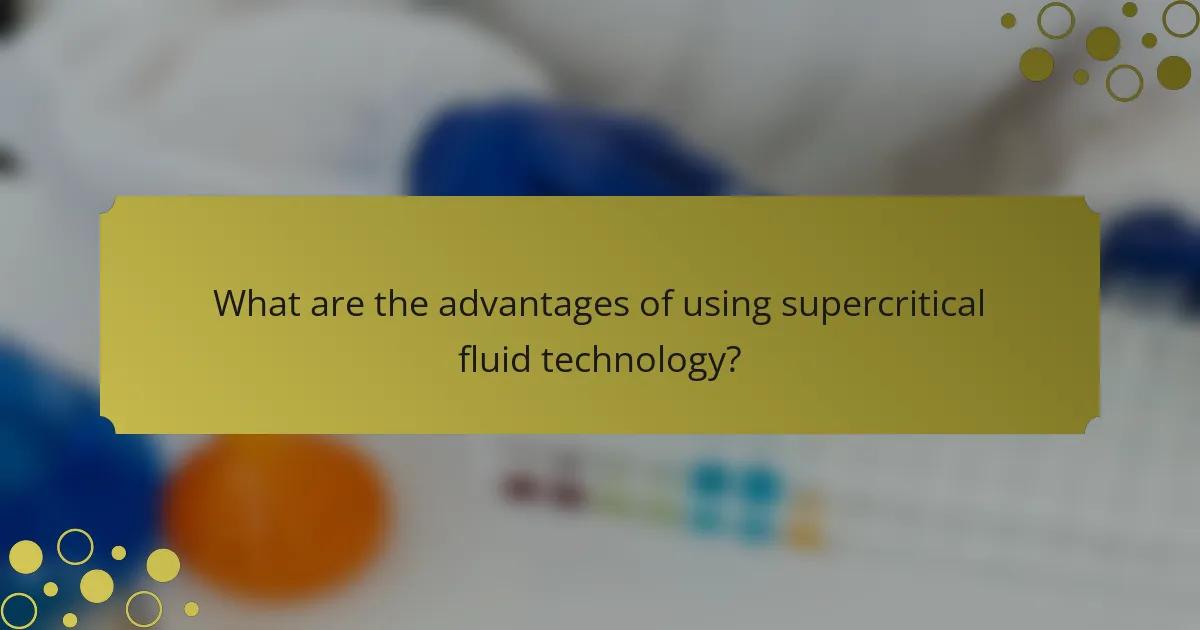
What are the advantages of using supercritical fluid technology?
Supercritical fluid technology offers several advantages. It provides enhanced extraction efficiency compared to traditional methods. This technology allows for selective extraction of desired compounds. It minimizes the use of harmful solvents, promoting environmental sustainability. Supercritical fluids can easily penetrate materials, leading to faster extraction times. The process operates at lower temperatures, preserving heat-sensitive compounds. Additionally, it can be easily adjusted by changing pressure and temperature, allowing for versatility in applications. Studies show that supercritical CO2 is particularly effective in extracting essential oils and natural products.
Why is supercritical fluid technology considered environmentally friendly?
Supercritical fluid technology is considered environmentally friendly because it often eliminates the need for harmful solvents. This technology utilizes supercritical fluids, such as carbon dioxide, which are non-toxic and recyclable. Unlike traditional solvents, supercritical fluids do not produce hazardous waste. They can effectively extract compounds at lower temperatures, reducing energy consumption. This process minimizes greenhouse gas emissions compared to conventional methods. Additionally, supercritical fluid technology can be applied in various industries, including pharmaceuticals and food processing, promoting sustainable practices. Studies show that using supercritical carbon dioxide can reduce solvent-related environmental impacts significantly.
How does supercritical fluid technology reduce the use of solvents?
Supercritical fluid technology reduces the use of solvents by utilizing supercritical fluids as a solvent alternative. Supercritical fluids, such as carbon dioxide, possess unique properties that allow them to dissolve substances effectively. This eliminates the need for traditional organic solvents, which can be harmful and environmentally unfriendly.
In many applications, supercritical fluids can achieve similar or superior extraction efficiencies compared to conventional solvents. For instance, in the extraction of essential oils or active compounds, supercritical CO2 can selectively target specific components without the use of harmful solvents.
Additionally, the use of supercritical fluids often leads to reduced energy consumption and lower waste generation. According to research published in the Journal of Supercritical Fluids, the application of supercritical CO2 in industrial processes has demonstrated a significant reduction in solvent usage, promoting greener practices.
What are the energy efficiency benefits of supercritical fluid processes?
Supercritical fluid processes improve energy efficiency by utilizing a fluid state that combines properties of both liquids and gases. This unique state allows for enhanced mass transfer and solubility, reducing the energy required for separation and extraction processes. For example, supercritical carbon dioxide can extract compounds at lower temperatures compared to traditional methods. This results in less energy consumption and reduced thermal degradation of sensitive materials. Additionally, supercritical processes often operate at lower pressures, which can further decrease energy input. Studies have shown that these processes can achieve energy savings of up to 30% compared to conventional extraction methods. Overall, supercritical fluid technology represents a significant advancement in energy-efficient processing.
What challenges are associated with supercritical fluid technology?
Supercritical fluid technology faces several challenges. High pressure and temperature requirements can complicate system design. Equipment must withstand extreme conditions, increasing costs. Solvent selectivity can vary, impacting extraction efficiency. Limited solubility of some compounds can hinder applications. Scale-up from laboratory to industrial processes poses additional difficulties. Safety concerns arise due to the use of flammable solvents under pressure. Regulatory compliance can also be complex, affecting project timelines. These challenges must be addressed to optimize supercritical fluid applications.
What are the economic barriers to implementing supercritical fluid systems?
The economic barriers to implementing supercritical fluid systems include high initial investment costs and operational expenses. The technology requires specialized equipment that can be expensive to procure and maintain. Additionally, the cost of energy consumption during the supercritical process can be significant. Limited availability of skilled personnel to operate and maintain these systems adds to the expense. Furthermore, there may be a lack of established supply chains for raw materials needed for supercritical fluid applications. These factors collectively hinder widespread adoption in various industries.
How do technical limitations affect the scalability of supercritical fluid applications?
Technical limitations significantly restrict the scalability of supercritical fluid applications. These limitations include equipment costs, operational pressures, and temperature requirements. High pressures are necessary to maintain supercritical conditions, which complicates equipment design. Additionally, the energy consumption for maintaining these conditions can be substantial. Limited solubility of certain compounds in supercritical fluids also poses challenges for large-scale applications. Furthermore, the complexity of process control and the need for specialized materials can hinder scalability. Research indicates that these factors contribute to the high cost and complexity of scaling up supercritical fluid technologies.
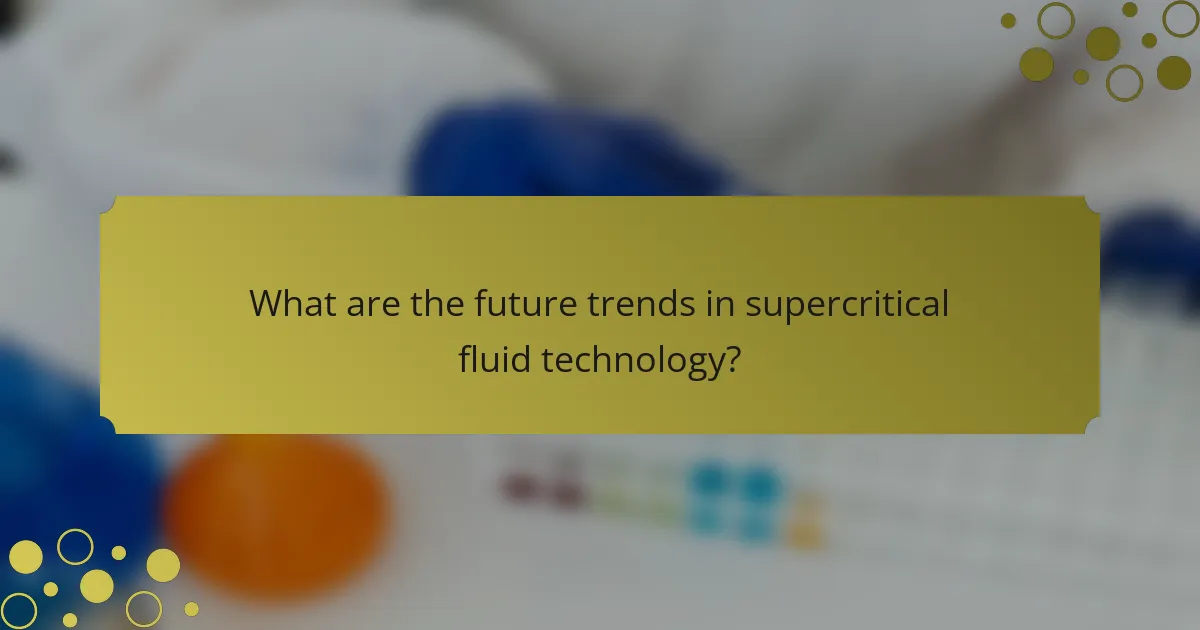
What are the future trends in supercritical fluid technology?
Future trends in supercritical fluid technology include advancements in extraction processes, increased applications in pharmaceuticals, and the development of more efficient systems. The extraction processes are becoming more environmentally friendly. This is due to the use of carbon dioxide as a solvent, which reduces toxic waste. In pharmaceuticals, supercritical fluids are being used for drug delivery systems. These systems enhance bioavailability and targeted delivery of medications. Additionally, there is a growing interest in using supercritical fluids for food processing. This trend aims to preserve nutrients and flavors without chemical additives. Research is also focusing on optimizing parameters for better scalability. The integration of artificial intelligence in process design is expected to enhance efficiency. These trends are supported by ongoing research and development in various industries.
How is research advancing supercritical fluid technology?
Research is advancing supercritical fluid technology through improved extraction methods and enhanced process efficiency. Innovations in supercritical carbon dioxide (SC-CO2) extraction have led to higher yields of bioactive compounds. Studies show that optimizing temperature and pressure parameters increases extraction rates. Researchers are also developing new solvent systems, expanding the range of materials that can be processed. Recent advancements include the use of supercritical fluids in pharmaceuticals for targeted drug delivery. Additionally, ongoing research focuses on reducing energy consumption in supercritical fluid processes. These improvements are supported by findings from various studies, highlighting the versatility and sustainability of supercritical fluid technology.
What innovations are being explored in supercritical fluid applications?
Innovations in supercritical fluid applications include enhanced extraction methods and improved reaction processes. Researchers are developing supercritical carbon dioxide extraction for natural products, which is more efficient than traditional methods. This process reduces solvent usage and increases yield. Another innovation is the use of supercritical fluids in pharmaceuticals for drug formulation. This technique allows for better solubility and bioavailability of drugs. Additionally, advancements in supercritical fluid chromatography are enhancing separation techniques for complex mixtures. These innovations are supported by studies showing increased efficiency and reduced environmental impact.
How might supercritical fluid technology evolve in the next decade?
Supercritical fluid technology is expected to evolve significantly in the next decade. Advances in equipment design will enhance efficiency and reduce costs. Research will likely focus on expanding applications across industries, such as pharmaceuticals and food processing. Environmental concerns will drive innovations in sustainable practices using supercritical fluids. Enhanced extraction methods could improve yield and purity of bioactive compounds. Integration with other technologies, like nanotechnology, may create novel solutions. Regulatory developments will influence the adoption of supercritical fluid processes. Overall, the evolution will be characterized by increased versatility and sustainability in applications.
What practical tips can enhance the use of supercritical fluid technology?
Optimize temperature and pressure settings for specific applications. Precise control enhances extraction efficiency. Use appropriate solvents to improve solubility and selectivity. Common solvents include carbon dioxide and ethanol. Regularly maintain equipment to prevent leaks and ensure safety. This practice prolongs the lifespan of the technology. Implement continuous monitoring systems for real-time adjustments. This allows for immediate response to changes in processing conditions. Train personnel thoroughly on system operations and safety protocols. Well-trained staff can optimize performance and reduce risks. Collaborate with research institutions for ongoing advancements. This can lead to innovative applications and methods.
What best practices should be followed for optimizing supercritical fluid processes?
To optimize supercritical fluid processes, it is essential to control temperature and pressure accurately. Maintaining optimal conditions enhances extraction efficiency and product quality. Regular calibration of equipment ensures precise measurements. Utilizing appropriate solvents improves solubility and extraction rates. It is important to optimize flow rates to maximize contact between the solvent and the material. Implementing continuous monitoring of process parameters can identify deviations early. Conducting thorough pre-processing of raw materials can enhance extraction outcomes. Finally, employing advanced modeling techniques can predict and optimize process performance effectively.
How can troubleshooting improve outcomes in supercritical fluid applications?
Troubleshooting enhances outcomes in supercritical fluid applications by identifying and resolving operational issues. Effective troubleshooting minimizes process disruptions. This leads to increased efficiency and product yield. For example, detecting pressure fluctuations can prevent suboptimal extraction rates. Addressing temperature inconsistencies ensures optimal solubility of compounds. Consistent monitoring and adjustments improve the quality of final products. Research shows that systematic troubleshooting can lead to a 20% increase in extraction efficiency. This highlights the importance of proactive problem-solving in supercritical fluid technology.
Supercritical Fluid Technology is a method that utilizes supercritical fluids, substances at a temperature and pressure above their critical point, for various applications including extraction, chromatography, and chemical reactions. This technology offers unique properties such as enhanced solubility and low toxicity, making it particularly valuable in industries like pharmaceuticals and food processing. The article explores the principles behind supercritical fluids, their key characteristics, the conditions required to achieve a supercritical state, and the advantages of using this technology, including its environmental benefits. Additionally, it discusses current challenges, future trends, and practical tips for optimizing supercritical fluid processes.

